A leather groover is a must-have tool for any leathercraft enthusiast, providing a professional finish to your projects by carving uniform lines and grooves. This handy instrument not only enhances the aesthetic appeal of your leather goods, but also ensures stronger, longer-lasting seams. In this guide, we will delve into the step-by-step process of using a leather groover, helping both beginners and seasoned craftsmen to fully leverage this tool’s potential.
What is a Leather Groover?
A leather groover is a tool used in the leatherworking industry for creating uniform, symmetrical grooves on the surface of leather. It consists of two parts – a handle and blade – and produces impeccably straight lines on any thickness of material from 0.5 to 5mm thick. The groover can be adjusted to create groove depths ranging from 0.2mm to 6mm, depending on the size and hardness of the leather. [1]
Setting Up the Tool
Before getting started with a leather groover, it’s important to ensure the tool is set up properly. The blade depth should be adjusted so that it creates a groove of the desired size without cutting into the material too deeply. It can be helpful to practice on scrap pieces before starting work on an actual project.
The tension screw should also be checked and adjusted to ensure that the blade is firmly attached to the handle. This will keep it in place while working and prevent it from slipping or becoming loose during use.
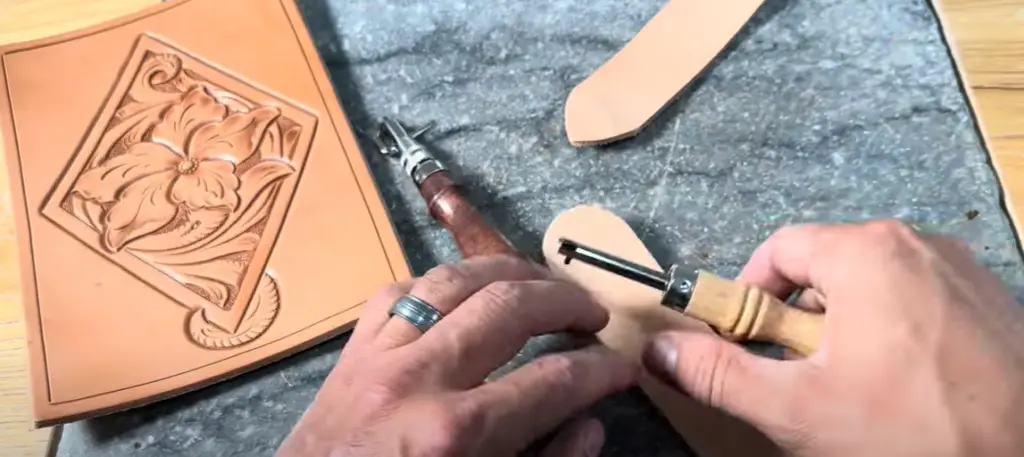
Using a Leather Groover
When using a leather groover, start by marking out where the grooves are needed with chalk or a marker pen. The tool should be lightly pressed onto the leather with a steady and even pressure, creating an even groove along the marked line. The grooves should be made in one continuous motion to ensure that they are perfectly symmetrical and straight.
Once the desired pattern has been created, the edges can be finished off with an edge tool or burnisher for a professional look.
Tips for Working With a Leather Groover
When using a leather groover, it’s important to take care and exercise caution. Always wear protective gloves when handling the tool and never use it on hard surfaces such as wood or metal. It’s also wise to practice on scrap pieces of material before attempting to work with an actual project. This will help ensure that the correct depth and size of grooves are achieved with each use.
When storing a leather groover, make sure to dry it off completely after each use and store it in an area away from direct sunlight or moisture. This will help keep it in good condition and prevent rusting or corrosion. [2]
Cleaning and Maintaining a Leather Groover
A leather groover should be kept clean to ensure that it produces the best possible results each time it is used. After every use, the blade should be wiped down with a cloth and lightly oiled if necessary. This will help prevent rusting or corrosion and keep the tool in good working condition for many years.
Regularly checking the tension screw and blade depth is also important when it comes to maintaining a leather groover. This will help ensure that the tool is producing perfect results each time, and that it is safely secured during use. With proper care and maintenance, a leather groover can be used for many years with excellent results.

Applying Heat to Achieve the Desired Result
When working with leather, the grooves created by a leather groover can be further enhanced by applying heat. This will help to soften and stretch the material, resulting in a deeper and more uniform groove for a professional finish. Applying heat can also be used to remove any imperfections or uneven edges caused by using the tool incorrectly.
When applying heat, it’s important to use caution and make sure that the temperature is not too high. Too much heat can cause discoloration or damage the leather, so it’s best to start with a low setting and gradually increase as necessary. A heat gun or iron is usually used for this task, but care should be taken when handling these tools. [3]
Safety Precautions
When using a leather groover, it’s important to take safety precautions to protect yourself and your materials. Always wear protective gloves and safety glasses when handling the tool, and make sure that the blade is firmly secured in place before use. It’s also advisable to practice on scrap pieces of material until you are comfortable with working with the tool correctly. Doing so will help you avoid any potential accidents or damage to the leather.
Additionally, always keep your workspace clear of clutter and sharp objects that may cause injuries during use. Make sure to unplug all power tools when not in use, and never leave the area while a tool is still running. These simple safety tips will help ensure that you get the best possible results with your leather groover.
The Benefits Of Using A Leather Groover
Using a leather groover is an effective and efficient way to create even, uniform grooves on the surface of leather. This tool can be used for a variety of projects, from creating decorative patterns on wallets or handbags to making perfect straps and belts. It is also very easy to use and maintain, allowing anyone with a bit of practice to achieve excellent results.
Using a leather groover is also much faster and more precise than doing the same job manually, saving time and effort in the process. With practice, anyone can quickly master this tool to create beautiful and professional patterns on any piece of leather. This makes it an invaluable addition to any leatherworking workshop or studio.
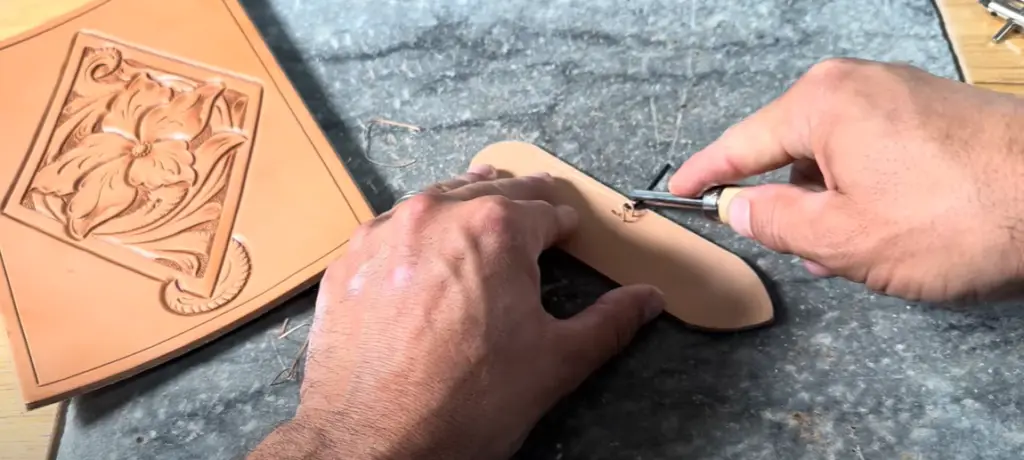
Drawbacks of Using A Leather Groover
Despite its many advantages, using a leather groover has some drawbacks that should be taken into consideration. The tool can be expensive to purchase, and the blades need to be replaced regularly in order to maintain their sharpness and precision. Additionally, as with all tools, there is always a risk of injury if it is not used properly.
It’s also important to note that leather groovers are not suitable for all types of leather. Thin or delicate materials may be prone to tearing if the tool is used too aggressively, so this should be taken into account when choosing a material for a project. [4]
Things to Avoid When Using a Leather Groover
- Avoid cutting too deep – You should only cut into the leather as much as is necessary to create the groove or line that you need. Cutting too deeply can cause permanent damage to your leather, and may result in an inferior quality product.
- Don’t use an overly sharp blade – Using a blade which is too sharp for the material you are working with can cause uneven lines, and can also lead to accidental cuts and tears. It’s important to find the right balance between a sharp enough blade for effective work, but not so sharp that it poses a hazard.
- Don’t use too much pressure – Too much pressure on your groover can result in unwanted jagged edges or poorly formed grooves which can make the leather look uneven or unsightly. You should simply press firmly enough to ensure that the groover is going where you need it to, but not so hard that it causes damage.
- Don’t force the tool – If your leather groover isn’t producing an adequate cut or groove then don’t try to push it too hard; instead use a different tool or adjust the blade to get the desired result. Forcing your leather groover could cause damage to both the material and the tool itself.
This is especially important when using a manual groover as it is much more difficult than an electric one to control.
- Don’t forget to clean – After you have finished using your leather groover, make sure to clean it thoroughly. This will help preserve the tool and allow you to get the most out of it in the future. A simple cloth and some leather cleaner should be enough to do the job. [5]
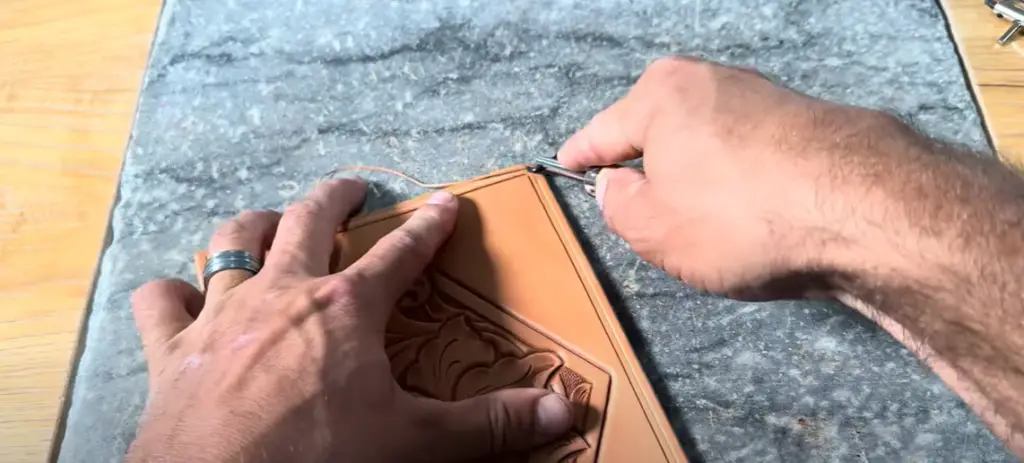
Ways to Ensure Quality Results When Using a Leather Groover
- Use high quality materials – Choosing top of the line leathers will ensure that you end up with a beautiful, even result when using your groover. The more uniform the material is, the better your results will be.
- Start with smaller lines – If you are a beginner, it’s best to start off with small, simple lines and slowly work your way up to more complex designs. This will give you the chance to practice controlling the tool without risking any accidents or mistakes.
- Use accurate measurements – For more intricate designs or when creating even spacing, make sure to measure the lines with a ruler or other measuring tool. This will ensure that your final results are exactly as desired.
- Use practice leathers – If you’re new to using a leather groover, it’s best to practice on some scrap pieces of leather before attempting anything important. This is an excellent way to get used to controlling the tool and can save you a lot of time and frustration in the long run.
- Take your time – Rushing through a project can lead to many mistakes, so it’s best to take your time when using a leather groover. This will help you achieve the best possible results with the least amount of effort.
- Use the right blade for the job – Different blades will provide different results, so make sure to use the one that is best suited for what you are doing. With practice and experimentation, you should be able to find the perfect blade for any task.
Following these tips will help ensure that your leather groover projects end in success! Remember, practice makes perfect and don’t be afraid to experiment with different techniques to see what works best for you. With a bit of patience and some dedication, you’ll be crafting beautiful leather masterpieces in no time!
FAQ
What is a leather groover?
A leather groover is a tool used to cut lines and create grooves in leather material. It can be manual or electric, depending on the type of project you’re working on.
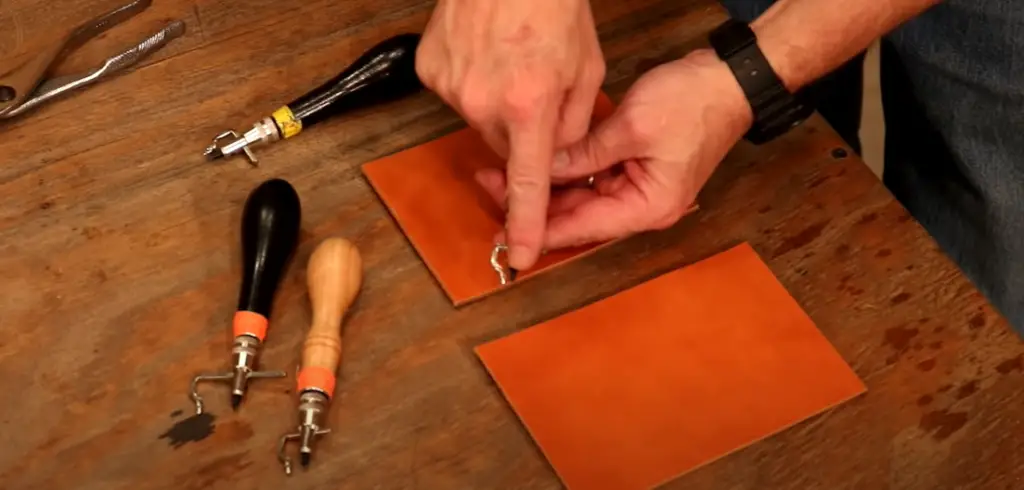
What are some tips for successful use of a leather groover?
Using high quality materials, starting with simple lines, taking accurate measurements, practicing on scrap leather, taking your time with the project, and selecting the right blade for the job are all important tips to ensure successful use of a leather groover. In addition, you should avoid cutting too deep into the material, using an overly sharp blade, applying too much pressure on the tool, or forcing it if it’s not producing an adequate cut. Don’t forget to clean the tool after use, as well!
What kinds of projects can I use a leather groover for?
A leather groover is great for creating intricate details such as embellishments and decorative patterns on leather goods. It can also be used to craft items such as wallets, belts, bags, and other accessories. Some people even use them to create detailed artwork! The possibilities are endless when it comes to leatherworking with a groover.
Is using a leather groover difficult?
Using a leather groover can be challenging, especially for beginners. It takes some practice and patience to get the hang of it, but once you have mastered the basics you’ll be able to craft beautiful leather goods with ease! With a bit of dedication and some experimentation, you’ll be an expert in no time.
What safety precautions should I take when using a leather groover?
When using a leather groover, you should always wear protective eyewear to protect your eyes from any flying debris or shavings. It’s also important to keep the tool away from any children or pets, as it can be dangerous if mishandled. Additionally, make sure that you are using a sharp enough blade for the job but not too sharp so that it poses a safety risk. Once you have finished with your project, remember to clean and store the groover properly. Taking these precautions will ensure that your leatherworking projects are safe and successful.
Do I need to maintain my leather groover?
Yes, if you want to keep your leather groover in working condition over time. Regular maintenance is especially important for an electric-powered groover since it can become clogged with lint, dirt, and dust. To maintain the device and its blades, remember to:
- Apply a thin coating of light machine oil or silicone lubricant after every use. This will help protect the blades from corrosion and abrasion.
- Wipe down the groover with a clean, damp cloth after each use to remove any remaining residue or dirt buildup. Make sure it is completely dry before storing away.
- Use a soft-bristled brush or air compressor to blow out any lint, dust, or dirt that may have collected inside the groover.
- Do not attempt to sharpen the blades of your leather groover; this could cause damage and reduce its effectiveness. Instead, replace them with new blades if they become too dull.
- Store your leather groover in a dry place when not in use, away from direct sunlight and extreme temperatures. This will help ensure it lasts for a long time.
Following these simple steps will keep your leather groover ready to use whenever you need it. It’s also important to always wear safety gloves and eyeglasses when operating the device, as the blades can be quite sharp. Doing so will help prevent any cuts or scrapes that could occur when handling the leather.
Is there a specific technique to using the leather groover?
Yes, there are a few things to keep in mind when using a leather groover. Start by setting the blade at the right depth for your project—the right depth will depend on how deep you want the groove, so make sure to measure it beforehand. You can also adjust the width of the groove by changing the position of the blades.
What other tools do I need for leather craft?
Aside from the leather groover, there are a few other tools that can be essential when doing leather craft. For example, an awl is useful for making small holes in the leather and piercing stitching holes. You’ll also need good quality needles for sewing and some strong thread to attach different pieces of your project together. Lastly, if you want to add decoration or color to your work, you’ll need special waxes and dyes made specifically for leather. With these tools and supplies, you’re ready to start crafting with leather!
What type of leather should I use?
The type of leather you choose will depend on the project you’re making. For example, if you’re making something that needs to be waterproof, you’ll need to choose a leather with a higher oil content. On the other hand, if you want something that is soft and supple, full grain leather might be a better choice. Different types of leather will also have different thicknesses and textures, so make sure to research each type before starting your project.
Useful Video: How to use an adjustable stitch groover
Conclusion
Leather craft is a great way to make beautiful and unique projects, but it’s important to have the right tools and supplies on hand. Investing in a quality leather groover is one of the best ways to ensure successful results with your work. With some practice and patience, you’ll soon be able to create amazing leather products that will last for years!
References:
- https://www.leatherskill.com/how-to-use-a-leather-groover/
- http://blog.leatheredgepaint.com/stitch-groover-pro
- https://www.weaverleathersupply.com/blogs/leathercrafting/the-leather-element-using-a-leather-stitch-groover
- https://www.reddit.com/r/Leathercraft/comments/2zu01i/how_do_you_use_a_stitching_groover_and_edge/
- https://favoredleather.com/leather-edge-groover-tool/



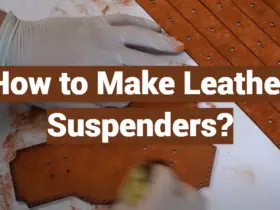

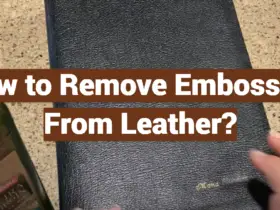

Leave a Reply